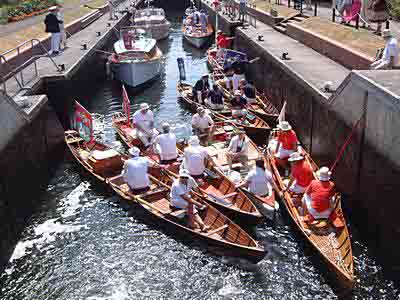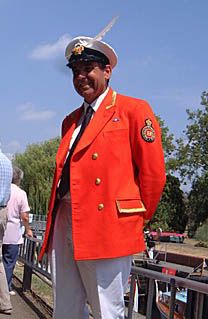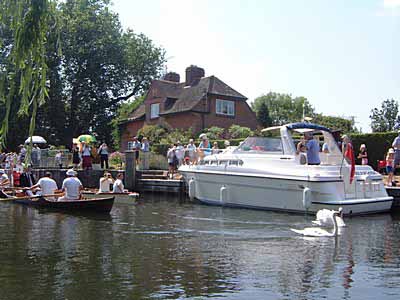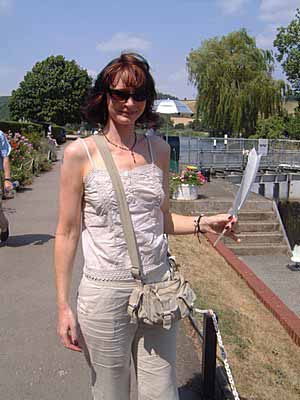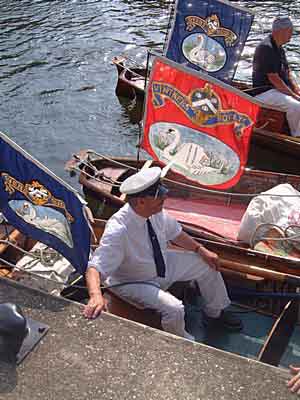![]()
![]()
THE
2006 SWAN-UPPING CEREMONY HELD ON THE RIVER
THAMES
The Last Vestiges of a Tradition Thousands of Years Old
Andrew Collins reports
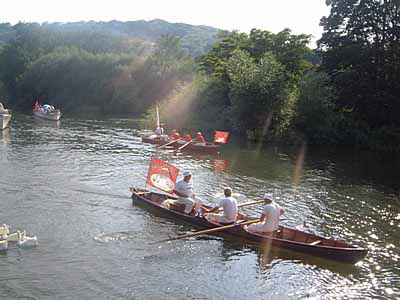
The Swan-upping flotilla reaches Goring Lock, Oxfordshire, on 20 July 2006 (Pic: Andrew Collins)
Thursday,
20 July. I travelled to Oxford and Berkshire
in pursuit of one of the River Thames's oldest traditions, the Swan-upping
ceremony, whereby all cygnet swans are weighed and marked during a colourful
journey that takes place over five days in July each summer. The whole
thing is conducted by members of two of London's oldest livery companies,
the Vintners and Dyers, who, along with the monarch's swan-warden, gradually
make their way from Sunbury, Middlesex, to Abingdon in Oxfordshire,
capturing any young bird they might come across. It is a truly royal
ceremony, as the reigning monarch is deemed protector of all swans in
Britain. On the Thames itself, only the Vintners and Dyers are granted
the right to own swans, this being in honour of their annual contribution
to the Swan-upping ceremony.
Swan-upping appertains not only to the 'upping' out of the water of the cygnets, but also to the up-river journey itself. In many ways, it is like a symbolic journey to the source of the waters of life, something that I am convinced has being going on here on the Thames for thousands of years. Officially, Swan-upping began only in the fifteenth century, but the Royal Windsor website speaks of it going back as far as the thirteenth century, and I argue in THE CYGNUS MYSTERY that it is an echo of something much more ancient, when the city's vintners came under the jurisdiction of the Roman temple of Isis, the inventor of wine, whose avataristic forms included the swan and goose. Moreover, the Vintners' Martinmas feasts held each year in honour of the swan resonate with pre-Christian traditions that saw this bird as the carrier of souls into the next world.
|
Our own journey began around midday on one of the hottest days of the year, when we caught up with the Swan-upping flotilla as it waited patiently for the gates to open in Mapledurham Lock, near Reading in Berkshire. Long wooden skiffs bearing either the blue flag of the Dyers or the red flag of the Vintners (both decorated with an image of the swan), carried white attired rowers (their blazers removed), while another bore the Queen's ensign. Accompanying the flotilla was a fleet of boats in all shapes and sizes. Some were full of the uppers' families and friends sipping champagne, drinking cocktails and looking like they were having a fine time. Others vessels were filled with swan enthusiasts, and still more contained people out on special day trips that follow the progress of the flotilla. |
Swan-upping flotilla awaits the opening of Mapledurham Lock (Pic: Andrew Collins) |
|
The swan-marker for the the Vintners Company at Maplestead Lock (Pic: Andrew Collins). |
Standing around
smiling and looking proud was the swan-marker of the Dyers sporting
a royal blue blazer, white trousers and a peaked cap bearing a
long swan's feather. His counterpart in the Vintners wore exactly
the same, although his blazer was in blazing red. Suddenly, the lock's gates opened allowing the flotilla to pass through into the open river. Quite by chance a pair of adult swans led the way in front of them as the poor birds attempted to get out of the way of the fast moving skiffs. It was a truly magical sight, like something out of a Wagnerian epic. Very quickly the whole armada was trailing away into the distance on their way now to Goring Lock, the Thames oldest crossing point. The two swans were still present, moving gracefully through the water in front of us, when unexpectedly one of them reared up its wings, stuck out its serpentine neck and head, and began making an awful cacophony. |
I thought it was having a fit, but then all saw as it ejected a large white feather, before settling back down again. As quick as a flash, we were on the bank attempting to will the long white feather in our direction, drawing it too us finally with a long stick. What a fine gift for the day - a feather straight from the back of one of the swans that had led the Swan-uppers out of the lock. It was an act that in the past would have been seen as particularly fortuitous by those belonging to a shamanic based society. I stuck it in my hat, and with the sun shining we moved on to the next site.
|
Two swans lead out the Swan-upping flotilla from Mapledurham Lock (Pic: Andrew Collins). |
Sue holds the feather disgorged from the back of a swan at Mapledurham Lock (Pic: Andrew Collins).
|
We had meant to catch
up with the Swan-upping flotilla in Goring-on-Thames, Oxfordshire, but
passing a riverside pub, appropriately named The Swan, in Pangbourne,
Berkshire, I suddenly noticed the blue and red flags of the Dyers and
Vintners, and realized that they had stopped for a much needed pint
and some lunch. This was odd as Sue and I had come across this pub in
January, and thought then that it would be a great place to await the
Swan-upping flotilla. Now they were here, and so we ordered our own
food and drinks, and absorbed the vibrant atmosphere. I talked to the
Clerk of the Vintners Company about THE
CYGNUS MYSTERY, and chatted to one man whose father had a very unique
job in the Swan-upping process. He rides ahead of the skiffs on a bike
looking for any cygnets. When he finds one he keeps watch over it until
the flotilla arrives.
|
Then, suddenly, the Swan-upping party headed back to their boats, and the armada left for Goring Lock, which we reached by car shortly before five o'clock. The Swan-uppers arrived 30 minutes later as a large crowd watched on, and as I took picture after picture I looked at the swan-markers, with their feathers, and saw in them the last surviving remnant of a tradition associated with the magical potency of the swan that went back over 17,000 years to when the Palaeolithic cave artists of Western Europe first depicted the Cygnus constellation in the form of a bird. What was once a coat of skin and swans' feathers worn by the shaman was today the decorative dress of the swan-wardens and swan-markers. Yet still the ceremonial world surrounding the swan persists here on the River Thames, and hopefully it will do so for many millennia to come, even if the cygnet count is now the lowest it has ever been. It is a tradition that embodies far more than simply a journey to the source of the waters of life, for it is also an expression of archaic swan shamanism that must never be lost to the world. |
The Swan-marker for the Dyers Company sits in his skiff at Goring Lock, the flags of both livery companies clearly in view (pic: Andrew Collins) |
We arrived home late, and just as we got out of the car Sue said that to make the day complete it would be great to see one of the Alpha Cygnids, meteors that appear to come from Deneb, the brightest star in Cygnus. They reach their maximum number per hour on 18 July, which has always made this astronomical firework display strangely coincident to the Swan-upping ceremony on the Thames each year. At that very moment a bright streak emerged from Cygnus and shot northwards, a perfect end to a wonder day.
For further information on Swan-upping, go to the Royal Windsor website here. See also the website of the London Vintners' Company for more information.
To secure your special
signed and numbered copy of THE
CYGNUS MYSTERY click here.
![]()
